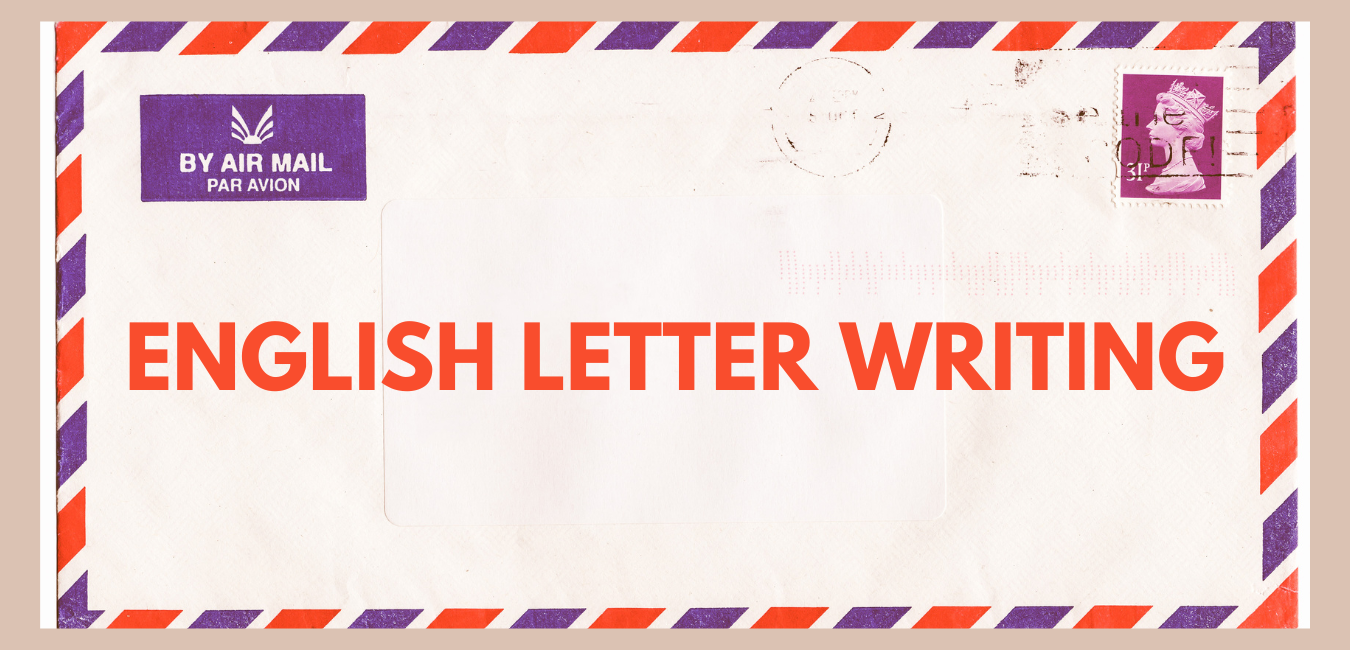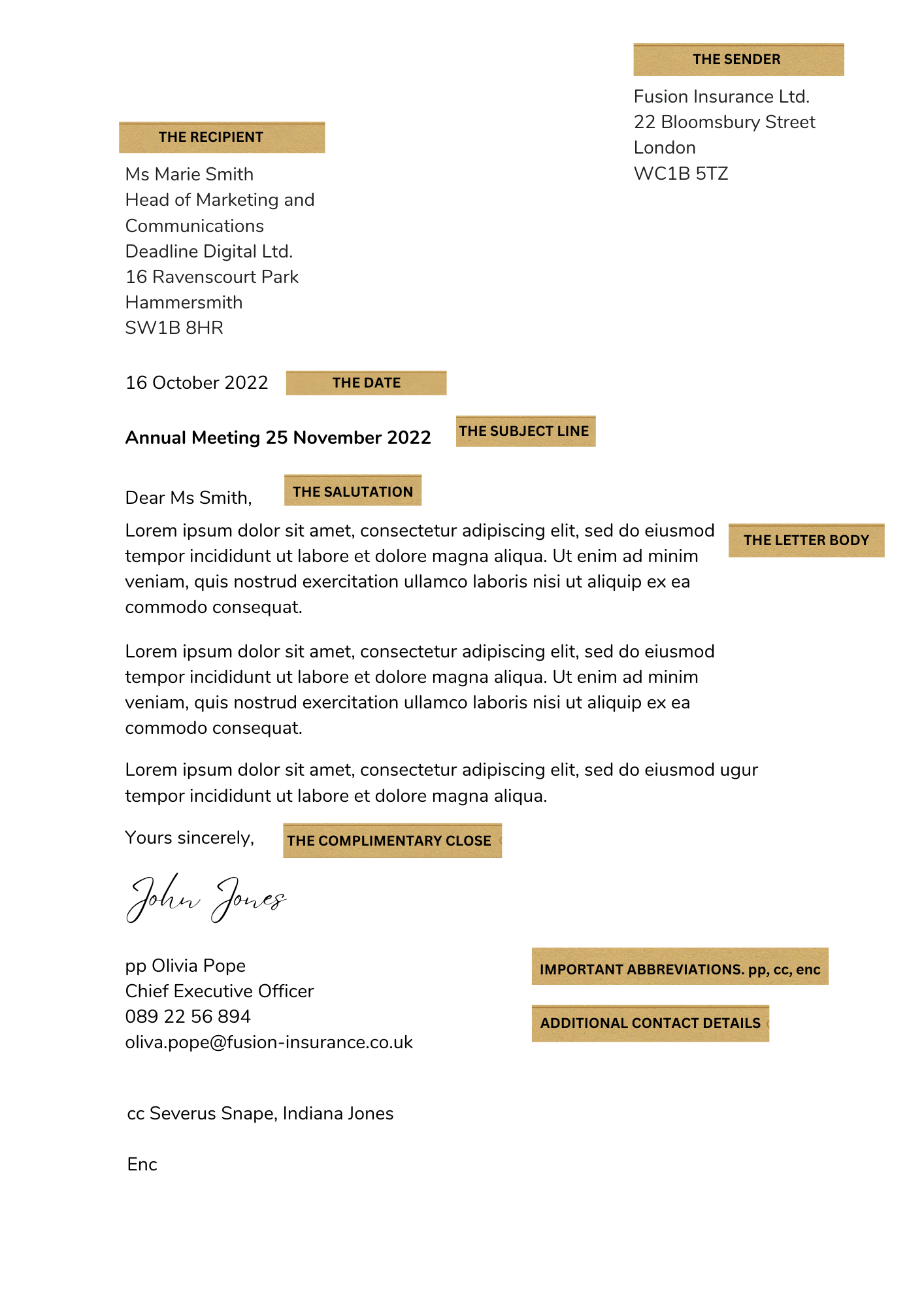Writing a letter in English? Confused about how to address the recipient? Struggling with comma and period placement? Get it right the first time with this helpful guideline to letter writing for the British English market.

British English Letter Writing
Business letter writing has come a long way in the past few decades. While today’s British English business letter still has the same classic format of old, phrasing has loosened up and adapted to become more contemporary and gender inclusive. Let’s take a look at the modern British English business letter, using the chronological structure: sender, recipient, date, subject line, salutation, letter body and complementary close.
The sender
If you have official business letterhead where the name and address of the company are already printed at the top or bottom of the page, you don’t need to worry about repeating the address again.
If this is not the case, or you are sending the formal English business letter as an individual, then print the sender’s address in the top right-hand corner of the page. If you are a small business with no official letterhead, you can place the business name and address either in the top right-hand corner or centre it at the top of the page.
Fusion Insurance Ltd.
22 Bloomsbury Street
London
WC1B 5TZ
(Note: in the UK, the postcode appears after the town or city name.)
The recipient
The name, title (job or role) and address of the recipient should be written on the left-hand side of the letter. You’ll find a good example in this correspondence from the Government of the UK website.
Ms Marie Smith
Head of Marketing and Communications
Deadline Digital Ltd.
16 Ravenscourt Park
Hammersmith
SW1B 8HR
The date
After the address, print the date, either a couple of lines after the address or shoot it over to the right-hand side of the page. In British English, the date starts with the day, then the month, then the year and, in a letter, no punctuation is required. Here is how you write the date according to the Cambridge Dictionary.
16 October 2022
The subject line
People are busy so it’s essential to communicate the main thrust of the letter in a short line before the main letter body begins. The subject line of a letter encapsulates your key message or purpose. It can also instantly provide helpful information to the recipient, for example, by featuring a reference number for correspondence that they sent to you.
While some letter writers like to introduce the subject line with ‘Re’ (the abbreviation of the word regarding), it looks cleaner to leave it out. Making it bold will draw immediate attention and help to communicate the message faster.
In British English, the subject line is positioned either directly before the salutation or between the salutation and letter body.
Re: Your correspondence 33A25BQ dated 7 September 2022
Annual Meeting 12 November 2021
The salutation
Recipient known: Do you know the name of the person you are writing to? Then, in a formal business letter, use ‘Dear Ms’ or ‘Dear Mr’ followed by their surname, for example, Dear Ms Smith.
Mrs is used if you know that the recipient is married. In general, nowadays, ‘Ms’ is the option of choice for addressing females – it’s a neutral, respectful term that can be used regardless of the person’s age or marital status.
If the recipient has a title, such as, Doctor or Professor, you should use the contracted forms. For Doctor, this is ‘Dr’ with no full stop. Professor, however, is contracted to ‘Prof.’ with a full stop or period. When the last letters of a contraction and the full word are the same, such as with Doctor and Dr, no full stop is required. (Note: there is no period after Mr, Ms or Mrs in UK English.)
(Note: the salutation in a British English letter is always followed by a comma.)
Dear Ms Smith,
Dear Dr Jones,
Dear Prof. Snape,
Naturally, if you are on familiar terms with the letter recipient, for example, you have done business together in the past or this is a long-term client you are writing to, then it’s fine to be informal and use a first name.
Dear Marie,
Dear Indiana,
Dear Severus,
If you know the recipient’s name but are unsure of their gender, you can use the first name or the initial of their first name with their surname:
Dear Marie Smith,
Dear M. Smith,
If the recipient is not British, the naming convention could follow a different format to the typical first name, surname one. There are plenty of resources online dealing with this subject. For example, this blog from the Asia Media Centre provides a detailed insight into Asian naming conventions.
Recipient unknown: What if you don’t know who you are writing to? For example, if you want to send a letter to a company but have no recipient name. In the past, ‘To Whom It May Concern’ or ‘Dear Sir or Madam’ or even ‘Dear Sirs,’ were used frequently. ‘Dear Sir or Madam’ is still a popular option according to the BBC. Hubspot calls “To Whom It May Concern” a lazy way to approach correspondence. It should only be uses as a last resort after all other options have been exhausted.
Nowadays, according to this article on UK legal website Legal Cheek, some law firms in the United Kingdom are leading the way by moving toward a structure that neatly avoids the recipient unknown problem while also being gender inclusive. This form simply uses the name of the firm:
Dear Linklaters,
Dear British Telecom,
This is a good alternative to both ‘Dear Sir or Madam’ and ‘To Whom It May Concern’ and it is certainly far preferable to the archaic and biased ‘Dear Sirs’.
A less formal approach in this case, and depending on the type of company you are writing to and the subject matter of your letter, would be the addition of the word ‘team’ to the company name to round it off more:
Dear Nike Team,
Dear Apple Team,
Gender-inclusive letter salutations
Gender-inclusive language helps us to avoid potential discrimination against the letter recipient. There are many ways to be respectful, inclusive and non-binary when addressing your letter recipient. Skip the Mr, Ms or Dear Sir or Madam, and try these ideas:
Dear ‘First Name’ + ‘Surname’
Example: Dear Jenny Smith, or Dear J. Smith,
Dear ‘Job Title’
Example: Dear Head of Marketing,
Dear ‘Company Name’
Example: Dear British Telecom,
Dear ‘Company Name + Team’
Example: Dear British Telecom Team,
Dear ‘Department’
Example: Dear Customer Services,
or
Dear Customer Services Department,
The letter body
Typically, the letter body is split into three blocked paragraphs. Each one should open with a capital letter and be brief where possible. The first paragraph should introduce the purpose of the letter. The second paragraph will elaborate and the third conclude.
The complimentary close
In British English, the rule for closing a letter is simple. If you used the recipient’s name, you sign off with ‘Yours sincerely’. If you didn’t, you use ‘Yours faithfully’. The complimentary close has a capital letter in the first word and a comma is placed after it.
Yours sincerely,
Yours faithfully,
Important abbreviations: pp, cc, enc
Are you working for a company and sending an English business letter on behalf of someone else? Then there’s a helpful abbreviation that you should know about. You can still sign the letter, but the name of the letter author and their title should be printed with the abbreviation for ‘per pro’ before the name. In the following example, John Jones is signing the letter on behalf of the Chief Executive Officer Olivia Pope:

If the letter is copied to another person, that name should be printed and preceded by the abbreviation ‘cc’, which stands for carbon copy. Last but not least, if attachments are included with the letter, point this out with the short version of enclosed ‘Enc’ near the bottom of the page.
Additional contact details
So that a recipient can get back to you promptly, add your phone number and email address to your final printed name and title. You don’t need to precede them with ‘tel’ and ‘email’.
Putting it all together
Here’s an example of the complete formal British English business letter with each of the sections discussed:

Looking for an experienced native English copywriter with SEO expertise in Munich or elsewhere in Germany? Let’s talk about attracting more traffic to your website. Contact us today to discuss your project.




